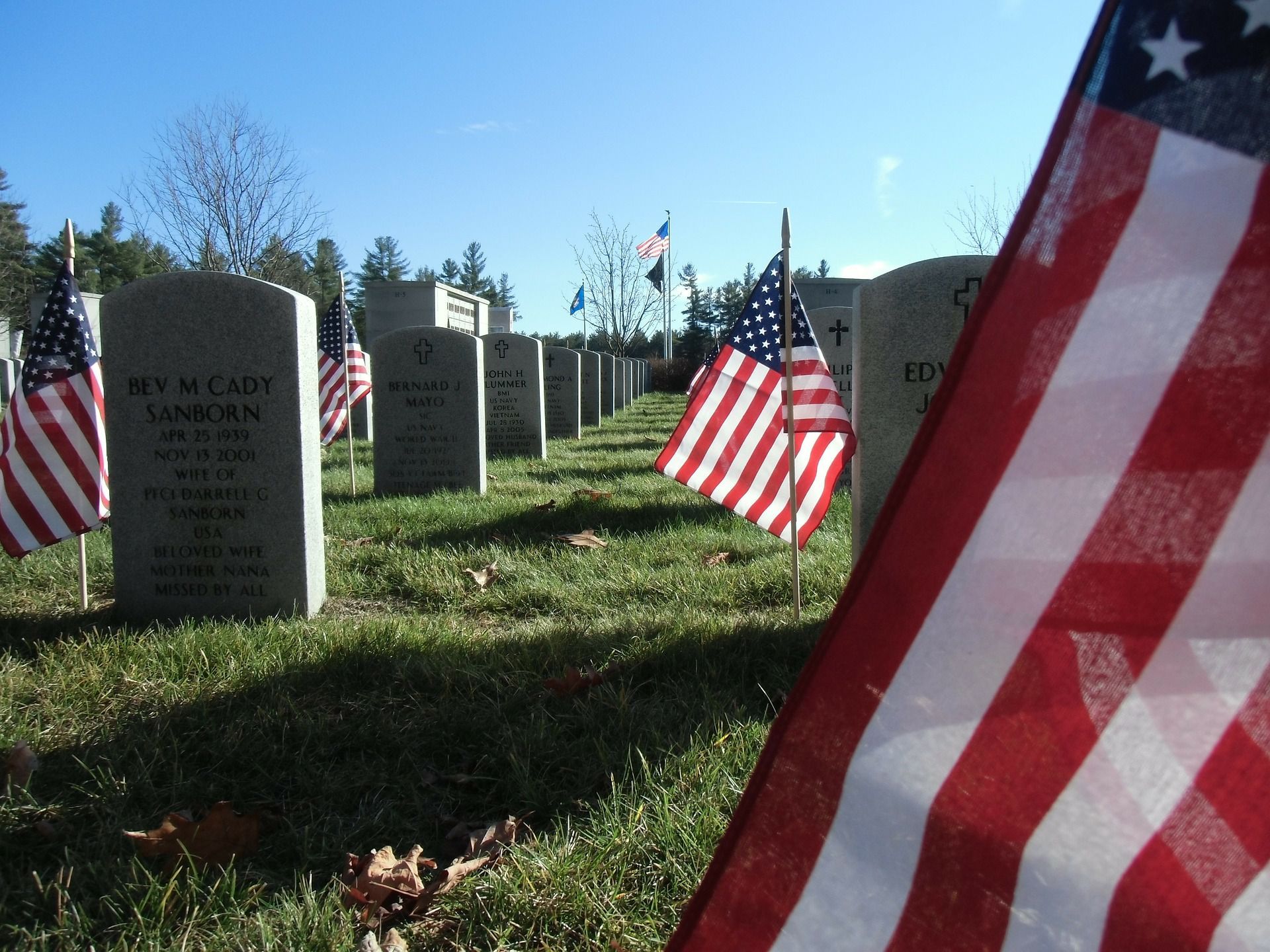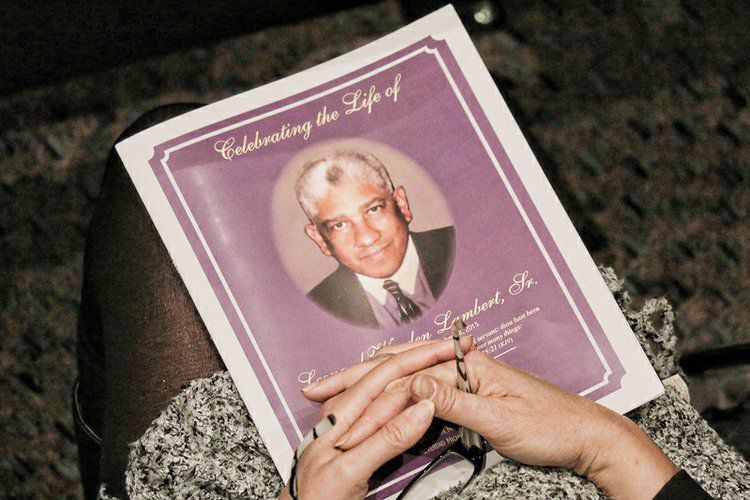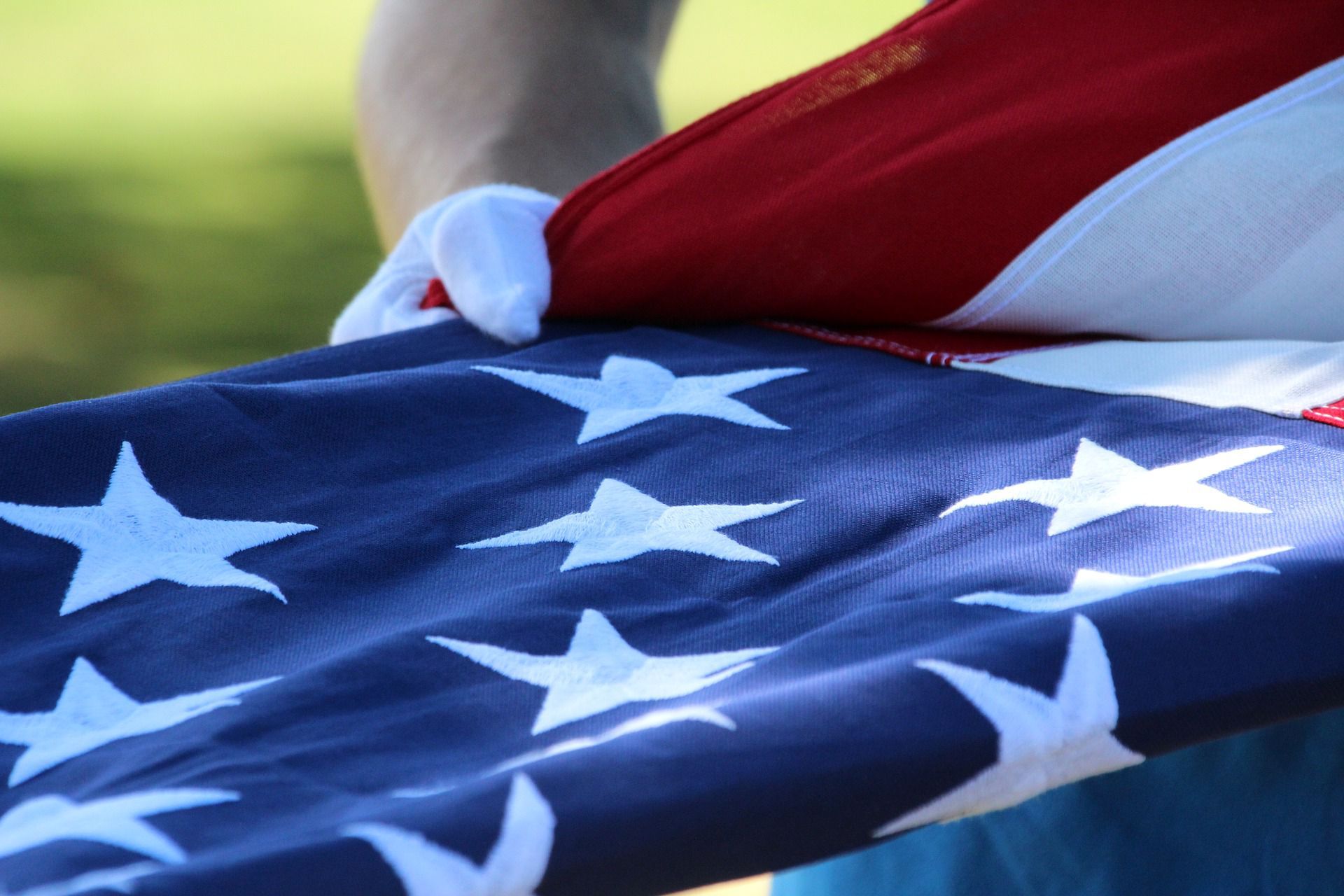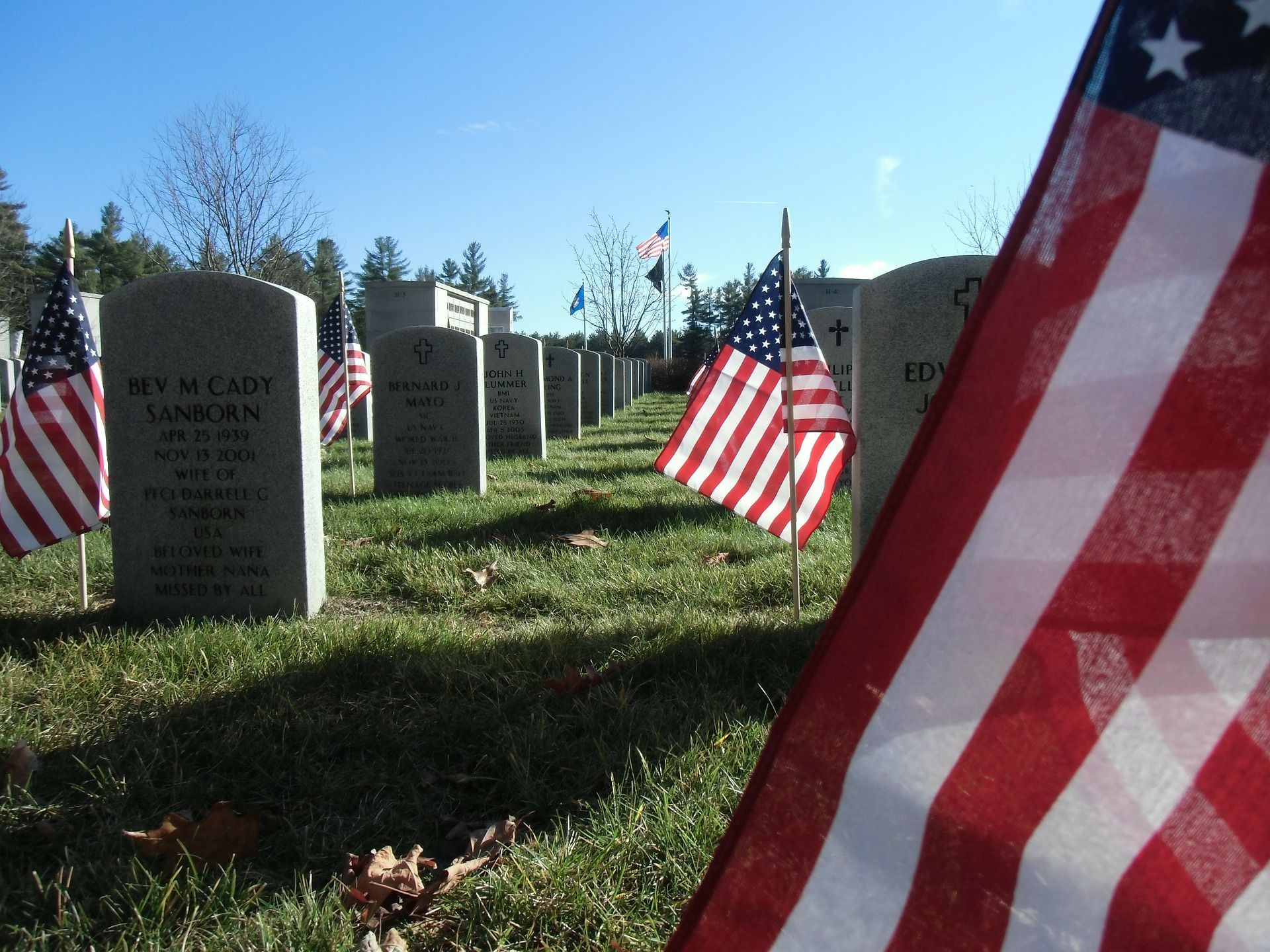BLOG
We write topical blog articles on the funeral process, offered services, Detroit funeral home customs and culture, and more. Select a blog article below to learn more.

While there are certain standards of etiquette that apply to all funerals, the funeral process at a national cemetery is slightly different than a traditional cemetery. Knowing what to expect at a funeral or memorial service can make the process more comfortable for everyone involved. If you are going to a ceremony for a deceased veteran at a national cemetery, here is what to expect. National Cemeteries Don’t Host Funerals It’s important to be aware that national cemeteries don’t have the facilities to host traditional funeral services or open-casket viewing. Sometimes, families will choose to have a funeral prior to the ceremony at the national cemetery. The service that is held at a national cemetery is called “final committal service” and it is held at a committal shelter. When you arrive at the national cemetery, there will be an official to direct you to the proper committal shelter (there are often several of these shelters at a national cemetery). The final committal service usually lasts less than half an hour and can include (or not include) military honors . Flowers At most national cemeteries, it is appropriate for the family to provide flowers for the service. These will often travel with the urn or casket from the committal shelter to the gravesite and ultimately be placed on the filled grave. Each national cemetery has an individualized floral policy, so it’s important to confirm that your arrangement is welcome. You Can Visit the Grave... Later Funeral attendees are welcome to visit the grave of the veteran after the work day is over, but not immediately after the committal service. Arlington National Cemetery is Differen t Arlington National Cemetery, which honors between 27 and 30 deceased veterans each day, has a slightly different process. Attendees will meet at one of four meeting points in or around the cemetery and should plan to arrive between 30 and 45 minutes before the service because of security procedures. Arlington National Cemetery often has funeral processions and military honors can be performed at the gravesite, unlike other national cemeteries. During the honors, which are performed after the graveside service, the family will stand but other attendees are free to sit. After honors, an Arlington lady may present a card of condolences. This is the conclusion of the service and attendees will return to their cars.

Poetry is an ancient form of written word that can bring immense comfort in times of grief. Death and loss are timeless subjects that have been explored by some of the greatest poets in history. If you have been asked to speak at a funeral, these poems can make excellent choices for readings. They can provide comfort and light during a dark and challenging time. 1. Death is Nothing At All by Henry Scott Holland Henry Scott Holland was a Professor of Divinity at Oxford and a canon of Christ Church in the late 1800s and early 1900s. This poem wasn’t a poem when it was first read, but a sermon written by the professor after King Henry’s death in 1910. The poem imbues listeners with a comforting sense that, though the deceased is gone, they are still close in heart and spirit. 2. A Child of Mine by Edgar Guest A deeply religious work, this poem is written from the perspective of Christ as a message to those who have loved the deceased, his child. It celebrates the honor of loving and caring for someone while they enjoy their earthly life, while also providing solace that the deceased has moved on to be with his Maker. 3. If I should die by Emily Dickinson Emily Dickinson is a recognizable name and her short, sometimes tragic, poetry has resonated with readers for centuries. This brief piece uses imagery of the natural world—“If birds should build as early/And bees as bustling go,”—to remind the audience that the world keeps turning. Death and loss can feel enormous and all-consuming, and this poem is a small, beautiful reminder that life goes on even as we experience grief. This idea is hopeful, because it means that we may someday be able to return to normality, if a bit changed. 4. Do Not Stand At My Grave And Weep by Mary Elizabeth Frye Like Death is Nothing At All, this poem reminds the reader that, though the deceased is gone in body, they are still present in spirit. This idea—that we carry our loved ones with us through experiences like feeling “the gentle autumn rain” or seeing “the diamond glints on snow,”—is a popular one that provides closure and peace during the sad occasion of a funeral. 5. Nothing Gold Can Stay by Robert Frost Another recognizable poet, Robert Frost was deeply inspired by nature. This poem outwardly appears to be about the seasons, which always change. It highlights the march of time that none of us can escape. This poem is a popular reading for funerals because it parallels the deceased with something gold—a good friend, a dear family member, no matter how loved, can never stay forever. 6. O Captain! My Captain! by Walt Whitman Another popular choice for funeral readings, Walt Whitman’s O Captain! My Captain! was written after the assassination of Abraham Lincoln. This poem, a bit darker than the previous ones on this list, still carries a sense of honor for the deceased. It is a popular choice for veterans or those who have worked together. While some of the images in the poem are forlorn, there is also a sense of celebration and positivity to the achievements of the deceased: “For you bouquets and ribbon'd wreaths—for you the shores a-crowding.” 7. Dirge Without Music by Edna St. Vincent Millay This poem is a very relatable one for a funeral. It is about the reluctance to accept death, despite its inevitability. Readers of this poem make positive associations with the deceased through lines like, “Gently they go, the beautiful, the tender, the kind/Quietly they go, the intelligent, the witty, the brave,” while also acknowledging the difficulty of loss. The Right Poem for You These are some of the most classic choices. While you might want to find a new or unique poem to read at a funeral (or even write your own), there can be immense comfort in a reading this is familiar to you and the audience. Choose a reading that resonates with you and brings you peace, and it is sure to be a wonderful addition to the funeral.

The program is a small and easy-to-forget part of a well-planned, organized funeral or memorial service. Sometimes called an order of service, the funeral program is a simple brochure or pamphlet that you hand out to guests. This document outlines the process of the service (what will happen) and sometimes includes a brief overview of the life milestones and achievements of the deceased. As with many features in a funeral or memorial service, programs are not “required,” but they can be a pleasant feature that honors the deceased and provides attendees with happy memories. If you decide to create programs for a funeral service, here are some tips. Do It Yourself or Outsource While planning a funeral is often an overwhelming duty, you might be able to find time to make your own funeral programs. Sometimes, outlining the life of your loved one can even be therapeutic and healing. It can also help you visualize the process of the funeral or memorial service, which can be comforting. If creating the program sounds too difficult or you just don’t have time, you can also outsource this duty to a printer or online service who will create and mail you the programs. You will still need to provide the information to be included in the program and an image of the deceased. The printer will also want some guidance about type of paper, art to be included, and font for the program. What to Include in a Funeral Program A funeral program is often a folded document, much like a greeting card. In this style, the cover includes a large image of the deceased, their name and life and death dates. The inside pages are for the obituary and the order of events for the service. You can also include copies of scripture readings or poems that will be delivered at the service. Another option, which also saves money, is to create a one page program. In this style, you can include a small image of the deceased at the top of the page, their name and life dates, and the order of events. You also have the option of including a short obituary on the back on the page, but it’s not necessary. Here is a short checklist if what to include in the funeral program: An image of the deceased Their full name Dates of birth and death Order of events for service Obituary ( click here to read more about how to write an obituary) Funeral Program Templates If you’ve chosen to create and print your own funeral programs, templates can be very helpful. There are plenty of places that you can find these. Canva is a free website that allows you to download templates, enter your personal information and add design elements. QuickFuneral.com also offers a variety of templates that you can download and edit. While you are free to simply use Microsoft Word or another text editing software, templates can offer a more professional, polished look for your funeral program. Are Funeral Programs Important? Funeral programs can provide a more organized experience during the funeral for guests and the family of the deceased. During a time of grief, organization and simplicity are important. But the creation of a funeral program shouldn’t be a burden or another source of stress. If you have time, the program can be a useful addition to the memorial service, but it shouldn’t upset you further during a time of grief. Make the right decision for you and your circumstances when it comes to creating a funeral program.

When someone dies, a grieving person can often find themselves surrounded by supportive friends, family, and even strangers. Because loss is a universal experience, the people around a grieving person are eager to help. Whether it’s because of a sympathy card, food, flowers, or just a kind word, you might find yourself feeling immense gratitude for your living loved ones before, during, and after a funeral. This gratitude, along with long-standing etiquette practice, often inspires people to write thank you notes after a funeral. Expressing thanks has been scientifically proven to increase happiness and stave off sadness, so writing funeral thank you notes can not only bring joy to those who recieve the cards, but also to the person writing it. Who Should Get a Funeral Thank You Note? If you choose to write funeral thank you notes, the first step is making a list of recipients. If you’ve just hosted a funeral for hundreds of guests, or even dozens, it might not make sense for you to write a thank you note to everyone for their attendance. It is entirely up to you who to send funeral thank you cards to. Perhaps you choose to only write notes for people who were actively involved in the funeral planning process, or only for those who brought food to the reception. Some etiquette manuals say thank you notes are only expected for those who brought flowers or other gifts—if someone only sent a card, you don’t need to respond with another card. Other options for recipients might include the funeral home staff, clergy, pallbearers, or people who spoke at the funeral. Ultimately, you should send notes to those who you feel grateful for, but without overwhelming yourself with tasks. What Should a Funeral Thank You Card Say? Your note should come from the heart—there is no stiff format for a thank you note. Especially if you are writing several thank you notes, keep your sentiments brief. You don’t want to add stress to a difficult time, and there is no need to write an essay of gratitude. Some common sentiments for funeral thank you notes: Thank you for your kind words at _____’s funeral service. Thank you for supporting our family during this difficult time. Your presence and help were very meaningful to me. Your thoughtfulness was very kind and will always be remembered. How to Sign and Address a Funeral Thank You Note Signing any card can sometimes seem challenging. If “Love” seems to personal, and “Sincerely” seems to unfamiliar, some other good options include: With Gratitude, Your Friend, With Fondness, Collecting addresses for everyone can also be one of the daunting tasks associated with writing thank you notes. Remember, the note doesn’t have to be a surprise. Don’t be afraid to call, text, or email a person and ask for their mailing address. Another easy way to collect addresses is to have a guest book at the funeral, in which everyone writes down their address. Don’t hesitate to ask a friend to collect some addresses on your behalf, too. Do What You Can While funeral thank you cards should be written as quickly as possible after the funeral, don’t put too much pressure on yourself. The most important thing to remember is that no one is expecting a thank you note. Everyone recognizes that this is a difficult, confusing time, and you are granted a reprieve from perfect etiquette during your loss. If you choose to write funeral thank you notes, take your time. While demonstrating your gratitude can make you feel better, it shouldn’t become a burden.

Death and funerals, while unpleasant for many of us to consider, are inevitable occurances that we need to prepare for, both emotionally and financially. As one gets older, the burden of care falls on younger, and often less financially stable, family members. This reality makes it all the more important that the elders within a family provide clear and practical next steps upon their death. No one wants their family’s grief and sadness to be compounded with financial stress. There are a number of ways for individuals to set aside money for their funeral services. Here are some tips and strategies. 1. Be Realistic Coming face-to-face with funeral costs can be jarring for some. The products, services and planning that go into creating a beautiful celebration of life can be expensive—there is no way around this. So it’s important to always remain aware of your personal financial standing and that of your family. It is possible to plan a beautiful memorial service without spending a fortune, it just requires some advanced planning and good advice from a trustworthy funeral director. 2. Set a Budget One way to be realistic is by setting a firm budget for yourself. Decide how much money you can afford to spend on your final celebration without burdening your fmaily with too many extra costs. Once you have set this number, it will allow you to be more decisive in your choices and realize what plans or dreams might have been a little beyond your financial means. 3. Shop Around Some people have an attachment to a particular funeral home, which often has long-term significance within the family. If you are unattached to a particular home, and live in a reasonably-sized city or town, you likely have several choices of where to host your funeral service. Take your time, meet with a few homes and funeral directors, and choose the one that works best for you and your budget. Remember that this is the company that your family will be working with after your death, so it might be reasonable to let them have some input, as well. 4. Set Aside the Money Setting aside money for a funeral can take many forms. You can literally place the money into the hands of the person who will be planning your funeral, but this is usually ill-advised—you have no control over what that money is used for, beyond expressing your wishes to the funeral planner. Irrevocable Funeral Trusts (IFTs) are another option, which we discussed in our last blog post. Many people choose to prepay for their funeral with a specific home. This not only ensures that your ceremony goes exactly as you intended, but it also locks in the prices at a current rate and prevents you from paying more because of inflation. The downsides to this strategy are that your chosen home might go out of business or you might move to a new area, which would require reassessment of this financial agreement. That said, prepayment is one of the most popular strategies for financially preparing for a funeral. A third way to set aside money for a funeral is with earmarked funds ina life insurance policy. These policies are called “permanent policies” instead of the more common “life-term policies.” Preparation is Key Whatever choices you make, the most important thing is that you make the choices. It’s unfair to leave all the decision making—and all the payment—to your family members. Especially if you have specific ideas about your memorialization, you need to ensure that a plan is in place before your death.

Planning for the eventuality of your funeral is always advised. By establishing your desires and arranging things as much as possible, you save your loved ones a lot of stress and overwhelm at the time of your death. One of the ways you can help your family after you have passed away is by establishing an Irrevocable Funeral Trust now. What is an Irrevocable Funeral Trust? Irrevocable Funeral Trusts are sometimes called I.F. Trusts, IFTs, Irrevocable Burial Trusts or Irrevocable Funeral Expense Trusts (IFET). An Irrevocable Funeral Trust is, quite simply, money set aside by an individual for the purpose of paying for that individual’s funeral expenses. The word “irrevocable” is very significant in this phrase: once money is set onto an I.F. Trust, it cannot be moved, eliminated or changed in any way other than for its determined purpose (paying for funeral expenses). The individual no longer owns this money, it belongs to the trust and ultimately, the trust’s beneficiary: the provider of funeral services. IFTs can pay for almost any services associated with a funeral, including the burial plot, embalming, the casket, and a variety of other expenses as defined by the trust document. Advantage of an Irrevocable Funeral Trust The primary intention of a trust is to reduce the stress on your family. Upon your death, your family will be grieving a loss. No one wants to have to crunch numbers and go shopping—it can be a very painful process to plan and pay for a funeral. A funeral trust saves your family from this stress. Disadvantage of an Irrevocable Funeral Trust The primary disadvantage of an irrevocable funeral trust is that costs can change. Because of inflation, it’s possible that the money you put in a funeral trust will not be adequate to cover funeral expenses by the time you die. Irrevocable Funeral Trusts and Medicaid Some people choose to put money in an IFT because it helps them to qualify for Medicaid. The money in an IFT doesn’t count as an asset and can therefore reduce a person’s countable assets, which then allows that person to qualify for Medicaid. That said, there are often limitations to the amount of money that can be placed in an Irrevocable Funeral Trust. These limitations are established by the state. How to Establish an Irrevocable Funeral Trust The first step in establishing an irrevocable funeral trust is to contact an estate planning attorney. The process of settuping up a trust such as this is a legal matter and should be completed with someone you trust. If you have a funeral home in mind for your funeral services, ensure that it will accept proceeds from the fund as payment, because some funeral homes do not. Keep Your Family Updated It’s important, with any legal document or end-of-life planning, to keep your family members and loved ones aware of your plans. Discuss this financial decision with you next of kin and ensure that everyone has a copy of the documents related to your IFT. This can help to expedite the process of accessing the funds when the time comes. IFTs are not the only option for financial preparation in regards to your death and funeral. Other options, such as funeral insurance and funeral pre-payment, have become more popular in recent years. However you decide to prepare, your loved ones will be grateful you did so.

One of the most important parts of most funeral services is the eulogy. A eulogy is a speech that celebrates the life of the deceased. Some funerals will have more than one eulogy, and some funerals will have no eulogy at all. Often, the family members that are planning the funeral will request a eulogy from friend or close loved one. The religious officiant of the funeral can also deliver the eulogy. What Should I Include in a Eulogy? Your eulogy should definitely include the things you loved about the deceased. The speech meant to be personal but also relatable, so while you should include anecdotes unique to your experience with the deceased, you should also include other stories from friends and family members. When possible, humor is always a good idea—funerals can be stressful and tense, and a little joke can go a long way to making guests feel more comfortable. But humor isn’t always accessible when you’re grieving a loved one, so don’t try to tell a funny story unless it comes to you naturally. If you are uncomfortable taking an emotional approach to a eulogy, it is also acceptable to highlight a person’s accomplishments and milestones in life. Mention their marriage, children and career, or discuss hobbies and passions. How Long Should a Eulogy Be? Like any speech, a eulogy shouldn’t be too long—never more than 10 minutes. Short and sweet is a good rule of thumb, but it’s also important not to be hasty or casual when writing and delivering a eulogy. Eulogies generally last between three and five minutes. The length of your eulogy will depend on how fast you speak. Generally, between 400 and 900 written words will make for an appropriately timed eulogy when delivered orally. Tips for Delivering a Eulogy Above all, you must practice delivering your eulogy. It’s not enough to simply write the speech—you need to say it out loud several times to become comfortable with how it sounds. When speaking publicly, remember not to rush—this is a common mistake and it makes your speech hard to understand. You should speak slowly enough that it feels a little unnatural. Also, use pauses throughout your eulogy so you can take a breath or a drink of water, and people can have time to process your words. Try to notice and eliminate ticks like tapping your fingers, playing with your hair, or wringing you hands. These little habits are often unconscious to you but they can be distracting to the audience. Your Eulogy Will Be Perfect If the funeral planner requested a eulogy from you, it means they have faith in your ability to honor their loved one and you will undoubtedly rise to the occasion. Even if your eulogy wasn’t specifically requested, speaking from the heart is guaranteed to convey your sympathy for the family and your appreciation of the deceased. Remember that a eulogy is part of the grieving process for you and everyone else, so don’t put too much pressure on yourself.

Did you know that you or your loved one can receive Military Funeral Honors even if the funeral is not at a Veteran National Cemetery? Not only is it possible to receive these honors for a service held in a private funeral home and cemetery, but their availability for eligible veterans is mandated by Public Law 106-65. What are Military Funeral Honors? The most basic services included in Military Funeral Honors are the folding and presenting of the flag (often to the widow/widower or next of kin) and the playing of taps. This process will be performed by a pair of Armed Forces members, one of whom will be from the deceased’s parent Service. If the body is transported, the flag will often be placed over the casket. This tradition goes back to the Napoleonic Wars when the bodies of fallen soldiers were removed from the battlefield wrapped in the flag. The flag usually remains on the casket for the bulk of the graveside service until the rifle volley. If the ceremony is held at a national cemetery, a team will fire three volleys from their rifles. The three volleys historically signaled a ceasefire and a time to clear the battlefield of casualties. Often mistaken for the 21-gun salute, the rifle volley typically precedes the playing of taps. Taps is a bugle tune (a live bugler will be provided when possible, but they are rather rare and often a recording is played) from the Civil War era. The composition was originally played to alert army camps to turn the lights out for sleep and has grown into a traditional musical farewell for service members. Before the casket is lowered, this flag is removed from the casket and folded by the two Armed Services members. The flag is folded in a very specific way that leaves only stars showing on one side. The presentation of this flag to the next of kin is a symbol of gratitude for their sacrifice. Eligibility for Military Funeral Honors As long as the military member was not dishonorably discharged, he or she is likely eligible for military funeral honors. The easiest way to confirm a loved one’s eligibility is to fill out DD Form 214, which will certify that the deceased was released or discharged from active duty. You can request this form from the National Archives . How to Request Military Funeral Honors The request for these honors is the responsibility of the funeral director . Once a family member expresses the desire to have these honors enacted at their loved one’s funeral, the funeral director will contact the military branch and arrange details. If the funeral is being held at a Veteran National Cemetery, the Administration will be the family’s point of contact for establishing these honors.

If you or a loved one is recognized as an American veteran, there are ways to potentially reduce or supplement the cost of a funeral and/or memorial service. The definition of veteran under federal law is very broad: “a person who served in the active military, naval, or air service and who was discharged or released under conditions other than dishonorable.” For a veteran to be eligible for funeral benefits, it is also important they were not dishonorably discharged. Any other type of discharge does not preclude them from funeral benefits. It’s possible that you might not have knowledge of your loved one’s service, especially if the deceased is a distant relative or friend. Therefore, it’s worth finding out if the funeral your planning is for a veteran. If so, you will have access to a variety of resources not available for civilian funerals. Burial Benefits Most veterans are eligible for burial in one of more than 130 national cemeteries (where there is space available). These national cemetery burials include: the digging and filling of the grave, a Presidential Memorial Certificate signed by the current president, an official marker or headstone, a burial flag, and perpetual care for the grave, ... all at zero cost to the veteran or his/her family. This process can be completed with a casket or ashes. The National Cemetery Scheduling Office is the point of contact for burial benefits. The office will determine the deceased’s eligibility and walk the funeral planner through the process of scheduling and organizing a funeral at a national cemetery. You can’t reserve a spot in a national cemetery, but you can determine your eligibility in advance. Burial Allowances If you’d prefer to host a funeral and burial in your local, family funeral home and church cemetery, veteran families can still qualify for allowances to offset the cost of these ceremonies. This allowance can range from $300 to $2,000 and you can even be reimbursed for a funeral you planned and paid for years ago. Written proof will be required; often in the form of receipts and a letter from the funeral director. There is an online application for burial allowances at vets.gov . Naturally, there are some limitations to these benefits. They will not be paid if the veteran died during active service or was a federal prisoner, for example. If a veteran chooses to be buried in a national cemetery, these allowances can offset the cost of transporting the body to the cemetery. Markers, Gravestones and Medallions Depending on when the veteran died, his or her grave may be eligible for a free gravestone, marker or medallion provided by The Department of Veteran Affairs. Gravestones and markers come in a variety of materials—granite, bronze, marble—and markers are also available for columbarium niches . A Presidential Memorial Certificate and a burial flag can also be provided free of charge. While the items themselves are free, the cost of installation for these pieces will be incurred by the family. A Ceremony Worthy of a Veteran Veterans who have served our country deserve the utmost honor in their memorial and funeral ceremonies. Benefits are available to make these final moments beautiful and worthy of the hero who has passed.

It can be especially hard to lose a loved one in the spring, when the blooming flowers, green grass and bright, sunny days in the natural world seem incongruous with inner grief and sadness. But the spring time can be a wonderful time to host a memorial or funeral service. Springtime means renewal, rebirth and life—all of which can be happily celebrated upon a loved one’s passing. Consider an Outdoor Location The more reliably warm and sunny weather of spring makes it possible to host a memorial service outdoors without fear of bad weather. While many regions get a lot of rain in the spring, the weather around these rainstorms is often pleasant and ideal for an outdoor ceremony of some sort. While a traditional burial service is always outside because the burial plot is in an outdoor cemetery, the spring makes it possible to host the entire funeral ceremony outside instead of just the burial portion. While this can provide convenience for everyone involved and also negates the need for a hearse and processional, some families might choose to make the lowering of the casket a private affair exclusively for nuclear family members. This doesn’t mean you can’t have an outdoor ceremony in another location, perhaps a backyard or outdoor destination that was special to the deceased, and then move to the cemetery for the burial. Just be sure to confirm that you are permitted to use the space if it is public, such as a park. Also, you’ll need to have more accessories for an outdoor ceremony that you might not consider for an indoor funeral, such as chairs, a tent, tables and a podium for the speaker. Use Spring Colors Springtime brings with it bursts of color which can provide a dramatic contrast to the neutrals of a traditional funeral. Pastel greens, blues and pinks evoke ideas of spring and fit well into a spring-themed funeral, but other options for color themes include any shade of green (including more bold options like emerald green and Kelly green), as well as turquoises and browns. Consider tying colored ribbons around the pews or chairs, dressing the deceased in a spring-colored outfit, or using a color scheme to choose funeral flowers. A note of warning: it can be easy to go overboard with color at any ceremony, especially a funeral, and this can start to look tacky. Try to keep your color arrangement to a few complementary colors and don’t hesitate to include a few neutrals to keep things classy. Use Spring Flowers Flowers are the greatest vehicle for communicating the vitality of spring. Not only do flowers fit in with the spring theme, but there will also be a wider variety of blooms available to funeral planners at this time of year. Some of the traditional spring-time flowers include the yellow-white daffodil, which is plentiful in March and April, the rich purple, pink and blue pansy, and the multi-colored tulip. Sweet peas, peonies and camellias are other spring-time options. You could also consider hosting the ceremony in a place with natural blooms, such as a botanical garden, or a backyard awash with rhododendrons, azaleas or crocuses. A Celebration of Life While grief can be a dark emotion, a spring-themed funeral or memorial service can serve as a light to combat that darkness. Creating a positive, colorful, fresh environment in which to celebrate your loved one can be therapeutic and this vibrant season offers the perfect venue for that.
